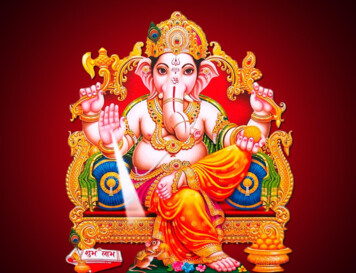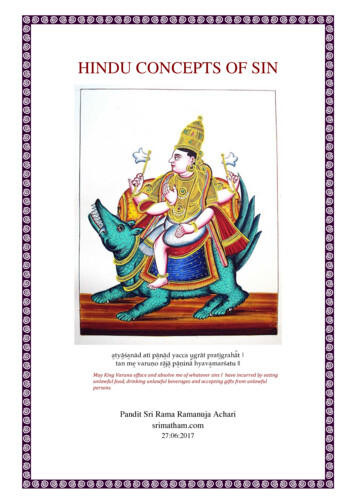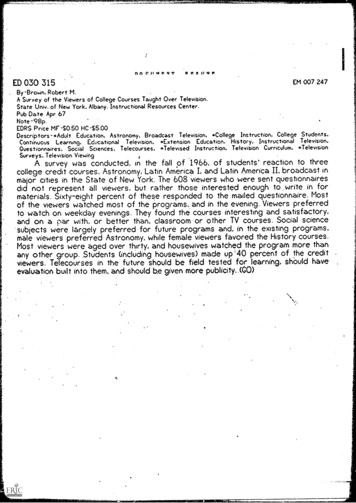
Transcription
A Comparison of Hindu and Buddhist Techniques of Attaining SamādhiEddie CrangleUnder The Shade of the Coolibah Tree: Australian Studies in Consciousness (R.A. Hutch& P.G. Fenner editors) University Press of America (1984)
A COMPARISON OF HINDU AND BUDDHISTTECHNIQUES OF ATTAINING SAMADHIEddie l'Yoga is the cessation of mind- movement.!Thus wrote Patafijali at the beginning of his y1gasutra, relating to his technique of attaining finaemancipation (moksa).Both Yogic and Buddhist schoolsof thought share fundamental presuppositions about yoga.Included, among others, are: a.) the equation; existence equals suffering, and b.) the doctrine of thepossibility of obtaining transcendental �@In addition, both schools stress aTheform of sel -discipline for obtaining release.growing preoccupation of contemporary western studiesin religion and the therapies etc., with the nature ofconsciousness, the essential characteristics of humansuffering. and the freedom from such, leads invariablyto the examination and theoretical consideration of theindividual's. efforts to master consciousness.Our editors, in the Introduction, understand suchexpertise to encompass' . a greater capacity to deployvarious forms of attention in a host of ways towards anyparticular objects, thoughts, and feelings which makeup the whole of our sensory environments"Yogicpractices, however, aim also to reduce those aspects ofthe consciousness flow which are viewed as hindrancesto attaining the . ideal of perceptual and cognitivefreedom', i.e. the final emancipation of highest!aml1dhi.Itmy intention, in this essay, to compareHindu and Buddhist techniques of achieving saml1dhi andthus to contribute, hopefully, a little to the clarification of some consciousness studies in Eastern traditions of philosophy, psychology, and religion.In particular, I will examine the method relatingto the samidhi of Patanjali's Yoga-sutra and to that of186187
the Buddhist P.Rupa and Arupa jィ。ョウセ@In these casestechnique refers to the gradual removal of hindrances,'to the refinement of consciousness, until the psychicflux is arrested and the experience of complete fusionof the subject and object of meditation ensues: then,' . the true nature of the object shines ヲッセエィ@notdistracted by the mind of the perceiver . 'a sense of 'I'.'Nir' forms are those without deliberation andreflection: the mind does not interfere and so thereis no 'I' sense.Both types are 'seeded' (sabija); that is, they are' . in relation with a 'substratum' (support) andproduce tendencies that are 7ike 'seeds' for the futurefunctions of consciousness.'In Patanjali's system of yoga there are eight stepsor stages: two, namely moral restraints(yama and disciplines of the body and psyche (niyama),are considered to be necessary preliminaries to theremainder: three are accessary to mind control bygoverning the disciplining of body (asana), vitalforce (pranayama) and senses Hーイ。エセィゥI@and the finalthree stages are the process by キィセ」@the experience ofunification occurs.These are concentration H、ィ。イセIL@meditation �(samadhi), descrrDea asstasis and conJunction.tィセ@three steps are knownas 'samrama'.The eighth stage, enstasis, is the finalphase 0 the unification process.Sa-vitarka samadhi, then, is enstasis when the mindhas a gross (sthula) aspect of the object of concentration as its base, while being accompanied bydeliberation and reflection.It is a direct perceptionof the object that extends into the past and future.Nir-vitarka samadhi is the moment when the object isempty of name and meaning: when the mind ceases linking verbal and logical associations with it and theobject is' . grasped directly . as a concrete andirreducible datum. '8Dharana is '. holding the mind in a motionlessfixing it to some mental or external objectby repeated effort.Eventually, an even current ofthought (dhyana), undisturbed by other thoughts, isdirected towards the object, thus allowing the yogin' . to intercept the flux of ordinary mental activity,'(citta-v!tti)4 which gradually diminishes as theabsorption-deepens.The result is samadhi.Sa-vicara samadhi is the level of knowing the subtleor inner aspect of the object of concentrationaccompanied with deliberation and reflection.However,in nir-vicara samAdhi, when absorption deepens andsupramental reflection ceases' . thought then becomesone with these infinitesimal nucleuses of energy whichconstitute the true foundation of the physical universe. '9Hセ。Iァ@ウエ。セGdy@When samadhi is obtained with the aid of an objectof concentration, this is called 'samErajnata-samadhi';the lower form of samadhi which is 't e accurate knowing of distinguishables'.5In samprajnati-samadhiare eight ontological levels of the contemplated objectand degrees of fusion attained.Each level has itsown mode of function or logic.It may be that theI states are not discrete but are differences discernedon a continuum.These are: a. vitarka, b. vicara,c. ananda and d. asmita, each of which have two forms:'sa'forms and 'nir' forms.'Sa' forms are 'propertied'when the object-oI meditation IS associated withdeliberation and reflection: the mind names the object(sabda), gives it significance (artha) and' . properties by comparison with some ッセエィゥョァ@HセイエゥI@onthe basis of remembered past experience. '6They have* Sanskrit has been used throughout except in caseswhere the Pali seemed appropriate. These are marked withthe letter 'P.'.188Hウオォセュ。I@At this same point of enstasis are found two otherforms of contemplation; Ananda-samadhi, associatedwith supreme joy - unspeakable bliss.This becomesthe object of concentration, and all perception,including that of the subtle aspect, is abandoned.This leads to asmita samadhi: the stage at which theself becomes the sole object of reflection and' . thereaches his true self and understands 'I amother than my body". '10This level of knowing is also called 'dharma-meghasamadhi': the 'cloud of dharma' in which the yogin' . feels that he is saturated (with virtues) and .has a feeling of 'Enough' in respect to all knowledgeand all consciousness . ' and so precipitates thesubject orientated enstasy - asamprajnata-samadhi. llAsamprajnata samadhi, procurJ'ed by supreme detachment or abandonment (para-vairagya) of all worldy ob189
jects, still remains seeded with subconscious impressions Hウ。エセォイI@but these are burnt up with repeatedpractiseuntil the yogin attains the nirbija(without seed) state of Kaivalya - ' . the enstasisof total emptiness, without sensary content orintellectua structure . in which the yogin is actuallyall Being. 'Emancipation Ifive psychological factors, previously mentioned arisein him.The object セs@reflection is taken up 。セ、@considered at length.This ウ・ュセA⦅エッ@me, to besimilar to the 'sa' forms of sampra nati samadhi inwhich the object of concentration,n its gross andsubtle aspects, is considered in similar light.to beThe samadhi of Buddhism is 」oセDゥ、・イ@similar to that of the Yo 9a-sutra 4 and the meditational techniques bear some sLmilarity, as I hope to show.In this instance, I will examine, mainly, the differentBuddhist Raptures HーNセᆬョ。I@in relation to samprAjnataand asamprAjnata sama 1.However, as concentration and bliss intensifiesthe second D.jhana is entered and the obstacles of applied and dLscursive thinking are dispensed with. 17The 'nir' forms of nir-vitarka and nir-vicara samadhibear a resemblance to this state in the sense that thegross and subtle aspects of that meditation areexperienced without reflection.1t3The Noble Eight-fold Path of the Buddha, likePatanjali's セエョァ。MケッL@is concerned also with moral,bodily,and mental discipline.The last three membersof the Path are directly related to the unificationprocess.These are: a. 'right exertion' (P.sammavayama), which, by controlling the emotive reactionsto external activity, wards off オョキィッャ・ウセ@mentalactivity; b. 'right mindfulness' (P.samma-sati),whichis the cultivation of awareness in order to keep themental contents under constant control and to producerelaxation of body and mind.This is done by choosing a certain body function, such as breathing, andfollowing it with the mind, and . the development of,unification' (P.samma-samadhi) which comprisesof eight meditative phases named P. 'jhana'.When the third p.jhafia is entered, zest isdispensed with, leaving appiness and one pointednessof mind.In this state ' . the sense of self isstill further diminished . セthere superveneisaclear, unruffled, perfectly conscious bliss . 'Ananda samadhi resembles this experience because ofsupreme joy being its object of concentration.However, the エイ。ョアオゥャセ@satisfying happiness (P.ptii)of the third p.{hana gives way to the subtle joy 0tranquil mindfu ness 19 which probably bears a greaterresemblance to thetowards asmita samadhi.The last stage of the P.Rupa Jhanas is reachedwhen any kind of emotion is stopped and all that remains of the five psychological factors is onepointedness of mind; consciousness of ッーセウゥエ・@is transcended creating perfect equanimityZO and consciousnesspasses beyond to the first of the P.Arupa Jhanas;the formless attainments.I am reminded, here, of therenunciation of dharma-megha-samadhi and エィセ@entry tothe subject orientated enstasy of asamprajnata samadhiby supreme detachment and abandonment of all worldyobjects.These phases of consciousness are progressivelyrefined until all false ideas of life, matter and thehindrance of thought are dispersed.Like the levelsof samadhi in the Yoga-Sutra, these are divided intotwo main types: the P.Rnpa Jhanas which are attainedby concentration and meditation on a mental or externalform and b. the P.Arupa Jhanas: the 'formless attainments. 'The four P.Rnpa Jhanas, the practise of mind-objectcontemplation, possess five psychological elementswhich are reduced as the concentration of mindintensifies.These are: 1. investigation (vitarka,P.vitakka), 2. reasoning (vicara), 3. zest (P.piti),4. happiness (P.plti-sukha) and 5. one-pointedness ofmind (P.ekaggatacitta).15The first P.jhana is the state of mind in which themeditation is disassociated from sense desires and the190It is at this point of the essay that I would liketo draw attention, again, to seeded consciousness andconsciousness without seed.When it is seeded,consciousness is affected by suppressed ideas and feelings which remain as tendencies within the mind: thesetendencies lose their ーoセiイ@to germinate in the higherrealms of consciousness.I feel that the ーNaイオセ。@Jhanas resemble the sabijawhic is seeded, at least, due tothe 1nc ination to sustain this samadhi.The formlessattainments are seeded to the degree that they owe their191セウ。イエョMュ、ィゥL@
BUDDHISTHINDUSAMPRAJNATA - Subject-Object Orientated.'seeded'4 RUPA JHANAS (P.) - Subject-Object Orientated.'seeded'SA VITARKA SAMAoHI'With Deliberation & Reflection','Gross Object of concentration is 'Propertied'SA VICARA SAMADHI'With Deliberation & Reflection''Inner' Aspect of Object of cッョ」・エイセ@is'Propertied',.SA ANANDA SAMADHI'With Deliberation & Reflection'Bliss as Object of concentration is 'Propertied'SA ASMITA SAMADHI'With Deliberation & Re1ection'Self as Object of Concentration is 'Propertied'1st JHANA (P.) - 5 Psychological Factors Present1, Investigation/Application of Thought(VITARKA,P.VITAKKA)2. Reasoning/Discursive Thought (VICARA)3. Zest4. Happiness5. One-Pointedness of Mind.NIR VITARKA SAMADHINOT 'lUth Deliberation & Re1ection'Gross object of concentration is NOT 'Propertied'NIR VICARA SAMADHINOT 'With Deliberation & Reflection''Inner' Aspect of Object of Concentration is NOT'Propertied'NIR ANANDA SAMADHIBliss as Object of ConcentrationNOT 'Propertied'2nd JHANA (P.) - 3 Psychological Factors PresentZest2. Happiness3. One-Pointedness of Mind1.Feeling of Bliss Intensified[]NIR ASMITA SAMADHI'Self' as Object of ConcentrationNOT 'Propertied'ASAMPRAJNATA - Subject Oriented 'seeded'Burning up subconsciousness impressions - WithoutSeed.[]Mセ[3rd JHANA (P.) - 2 Psychological Factors Present1. Happiness2. One-Pointedness of Mind1.JoB!.2nd3rd(P.) - 1 Psychological Factor PresentOne-Pointedness of MindJRANAS (P.) - Subject Orientatedrormless Attainment "Seeded"ItIftfIt"IfItIt- Without Seed192193Limit of Karmic ActioP.NIBBANA
movement, through the levels of consciousness, to karmicmomentum and that the fourth p.AruKa Jhana is the stageof transition to consciousness wit out seed.Asconsciousness becomes increasingly purified' . thecomplete removal of one セイオー。I@stage constitutes theattainment of the next. 'of defilements, uncompounded, infinite, and eternal.Both are profoundly concerned with unconditioned consciousness.Furthermore, some doubt exists as towhat is implied by the 'destruction' of consciousness'i.e., when consciousness , stops " or ceases' on the 'attainment of nゥイカ。セN@The first formless attainment is when the meditatorabandons form as his object of concentration andpractices space concentration 2 3 to realize the sphereof space-infinity (P.akasayatana).Even so, he GNセ@sees that his attainment is shadowed by the rupa-Jhana(and) wishes to attain the state of infinite consciousness, considering it to be even more tranquil. '24Bycontinuing this practice, he passes beyond the sphereof infinite space and enters the sphere of infiniteconsciousness: the second formless attainmentIt is not said to be annihilated.It no longertransmigrates. 29What happens to it?Perhaps this isthe essential difference between Kaivalya and Nirvana:the fact that Buddhism makes no positive statement aooutthe final state of the released.Buddhist doctrinedeclares: 'In the dead man, not only are the threeformations (verbal, bodily and thought formations)stilled but vitality is cut off, heat is cut off thefaculties are cut off.In a man who has entered theattainment of the dissolution of perception and sensation, although the (three) formations are stilled,vitality, heat and 58e faculties are not cut off.Thisis the difference.'It could be that this differenceapplies equally to the achiever of Kaivalya and thatnゥイカ。セ@equates with the nirbija state of is, also, is seen as an imperfection so ' . theconsciousness lets go of every concept . and enters asphere where no-thing at all exists, not even theperception of nothingness (p.akificafifia*atana) Selfconsciousness is eliminated and' . t e knower andknown are merged in unity. '25Yet, the bliss of its tranquility is felt as subtleperception and this can only be neutralized by enteringthe sphere of neither-perception nor non-perception(P.nevasannanasannayatana).Thus,' . the limit ofall karmic action is reached; '26 the yogin is at thefinal and transitional stage to the attainment ofnゥイカ。セ@' . which is the total suspension of mind,mental-properties, and the mental qualities associatedwith mind. '27There is similarity between Yogic and Buddhisttechniques of attaining samadhi but in each case theemancipation is thought to be different.While admitting that yogins and non-Buddhist ascetics could haveaccess to the eight transic states (P.jhanas),theBuddhists denied the authenticity of any claim by nonBuddhists to the attainment of the ninth state which isthe release of nゥイカ。セZ@the destruction of consciousness and ウ・ョ。セゥッ@whIch was specifically a discoveryof the Buddha. 8Whilst Buddhists (and others) wouldargue that Kaivalya and nゥイカ。セ@are completely different, the argument is ー・イィセウ@not so clear cut.Thereis a striking 」ッイ・ウーョ、セ@between Kaivalya andnゥイカ。セ@in that both are thought of as pure, free of194In conclusion, I note that both Hindu and Buddhistyogins, after a period of moral and physical discipline,developed proficiency at attaining a degree of enstasywith the object of their concentration and, by thegradual removal of hindrances to consciousness, managedto intensify the degree of enstasis; eventually,object-orientated enstasis was transcended and a degreeof formless attainment/subject-orientated enstasisensued.This however, was still liable to subtlepartiality but was eventually surpassed to attainliberation and '. the knowledge of the オャエゥセ・@reality of all objects, material and phenomenal.'yッセ。@References1 Isherwood & Prabhavananda, How to Know God:Aphorisms of Patanjali, (N.Y.: New American セゥ「イ。@19 9), p .11.The2Ibid ., p.122.3Mircea Eliade, From Primitives to Zen, (London:Collins, 1967), p.500.195
l8Humphries, op.cit., p.180, quoting BhikkhuSilacara.4Georg Feuerstein, Textbook o;f Yoga,(London: Rider,1975), p.l3D.SIan Kesacodi-Watson, Samadhi in Patafijali's yッァ。セ@Sutras, (Australia: an unpublished manuscript, 1980),p.l3.19Feuerstein, op.cit., p.58.2 Mahathera Vajirananda, op.cit., pp.272 279.6Ibid ., p.1S.21Humphries, op.cit., pp.183 184.7Mircea Eliade, YOfa: Immortality and Freedom,(N.Y.: Panthean Books, 958), p.83, sara-samgraha.22Mahathera Vajirananda, op.cit., p.332.23Upattissa, vゥュオエ。セL@(Colombo: Dr. Weerasuria, 18Ibid ., pp.8l-83.Rセ。ィエ・イ@9 Ibid ., p.83.(The Path of Freedom)1), p.113.Vajirananda, op.cit., p.459.25Humphries, op.cit., p.182.lD Ibid . p. 84, quoting Yisnanabhiksu' s YogasarasaJ.b.graha.26 Ibid ., p.183.llIbid., p. 84.27Mahathera Vajirananda, op.cit., p.465.12Feuerstein, op.cit., p.132.28Eliade, Yoga: Immortality and Freedom, op.cit.,pp.173 l74.l3Eliade, Yoga: Immortality and Freedom, op.cit.,pp.93 95.tィouセエL@14 Ibid ., p.17D.29Edward J. Thomas, The hゥウエッイセ@of Buddhist(N.Y.: Barnes and Noble, 1 11, 1st. publ.,1933 , p.132.3DUpatissa, op.cit., p.325.31Lama Thubten Zopa, The Wish Fulfilling GoldenSun of the Mahaiana Thought Training, (an unpublishedmanuscript), p. 21.16Christmas Humphries, Concentration and Medita'tion(London: Watkins, 1973), p.180.17Edward Conze, Buddhist Meditation, (London:George Allan & Unwin, 1956), p.117.196BibliographyBuddaghosaVisuddhimagra (The Path ofPurity) (tr. Fe Maung TinLondon: Luzac, 1971.197
The Practice of Zen.U.S. :Perennial Library, 1970.Buddhist Meditation.London:Conze, EdwardGeorge Allan & Unwin, 1956.From Primitives to Zen.London:Eliade, MirceaCollins, 1967. Fount. 1977.Yoga: Immortality & Freedom.Eliade, MirceaN.Y.: Panthean Books, 1958.The Essence of Yoga. London:Feuerstein, GeorgRider, 1974.Textbook of Yoga. London:Feuerstein, GeorgRider, 1975.'Mysticism and Meditation, 'Gimello, Robert M.in Mysticism and PhilosophicalAnalysis. (ed.) S.Katz.London: Sheldon Press, 1978.Creative Meditation and MultiGovinda, Lama AnagarikaDimensional Consciousness.G.B.: Mandala, 1977.Gセ・カャッーュョエ@of QuiescenceGUenther, H.V. and(Samatha).' in Mind inKawamura, L.S.Buddhist ーウケ」ィッャセN@Emeryville: la: D arma Pub.,1975.Happold, F.C.Prayer and Meditation. U.K.:Penguin, 1971.Humphries, ChristmasConcentration and Meditation.London: Watkins, 1973.Isherwood, C. andHow to Know God: the YogaPrabhavananda, Swami(trs.)Aphorisms of Patanja1i. N.Y.:New American Library, 1969.Isherwood, C. andShankara's Crest jewel ofPrabhavananda, Swami(trs.)Discrimination. Viveka-chudamani. Ca:Vedanta Press, 1978,sra-ed., lst.publ., 1947.Johansson, Rune E.The Psychology of Nirvana:London: George Allan & Unwin,1969.Kiyota, Minoru (ed.)Mahayana Buddhist Meditation:theory and Practice.Honolulu:Univ. Press of Hawaii, 1978.Lama Thubten ZopaThe Wish Fulfilling Golden Sunof the Mahayana Thought Train198Chang, Garma C.C.Lu K'uan YUThe Secrets of Chinese Meditation. N.Y. Weiser, 1972.Outlines of Hinduism. Bombay.Chetana, 1961.Samadhi. London: George AllanUnwin, 1976.Mahadevan,T.M.P.Mouni SadhuNyanaponika TheraThe Heart of Buddhist Meditation. London: Rider, 1972.Exploring M,sticism. G.B.:Penguin, 19 5.Secrets of Mind Control.India: N.K. Prasad, 1959,2nd -ed.A Practical Guide to Samadhi.India: N.K. Prasad, 1957.theStaal, FritsSwami NarayanandaSwami NarayanandaSwami VivekanandaSwearer, Donald, K.Tenzin Gyatsothe 14th Dalai LamaEdward J. ThomasThubten Kalsang Rinpoche& Bhikku PasadikaUpathissaVajirananda, MahatheraSecrets of the Lotus.Macmillan, 1971.The Buddhism of Tibet and theKey to the Middle Way.London: George Allan & Unwin,1975.The History of BuddhistThought, N. Y.: Barnes &Noble, 1971, 1st publ., 1933.Excertts from the suranfamaSamadi Sutra. Dharamsaa:Library of Tibetan Works andArchives.Vimuttimagga. (The Path ofFreedom). ColoiIibo: Dr.Weerasuria, 1961.Buddhist Meditation in Theoryand Practice. Colombo:Gunesana, 1962.* * * *199
In Patanjali's system of yoga there are eight steps Hセセセ。Iァ。I@ or stages: two, namely moral restraints (yama and disciplines of the body and psyche (niyama), are considered to be necessary preliminaries to the remainder: three are accessary to mind con











